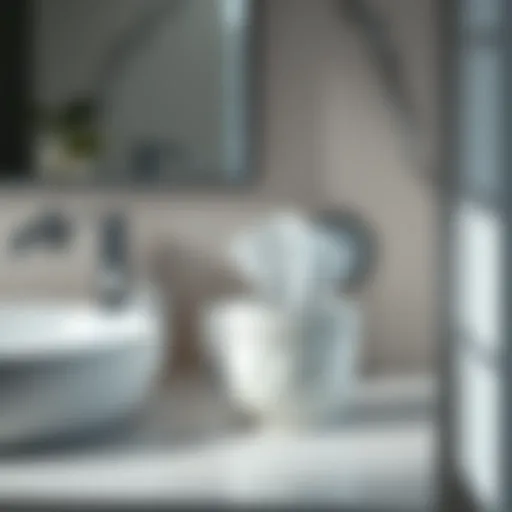Bathroom Renovation Tiles: Essential Tips for Success
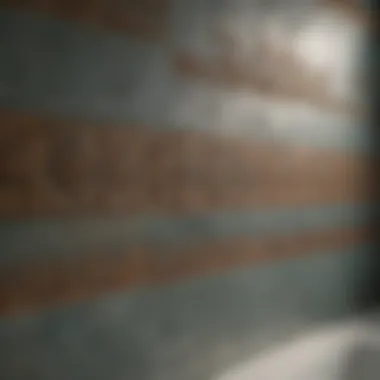

Intro
Bathroom renovation is more than just tossing some tiles on the wall and calling it done. It’s all about creating a sanctuary where aesthetics meet functionality. With the multitude of options available nowadays, choosing the right tiles can feel like navigating a maze. From ceramic to natural stone, and from glossy finishes to matte, the choices are endless. This article aims to provide a comprehensive guide to selecting, installing, and sustaining tiles in your bathroom.
Understanding the interplay of design trends and practical considerations is critical for any homeowner or renter looking to elevate their space.
Design Inspirations
Latest Trends in Bath and Bedroom Design
When diving into bathroom tiles, it’s important to be aware of the latest trends that will not only keep your space fresh but also reflect your personal style. In contemporary design, there’s a shift towards natural materials. Tiles that mimic wood, for instance, can add warmth while being durable and water-resistant.
Another hot trend is the use of large format tiles. These tiles reduce grout lines, giving a seamless look that exudes sophistication. Patterns like herringbone or chevron can also bring an added layer of texture and visual interest to the room.
Accent walls with bold patterns or textured tiles can instantly transform the vibe of your bathroom, adding a touch of drama and personality.
Color Palettes and Themes
Selecting the right color palette plays a crucial role in creating the mood of your bathroom. Neutral tones such as whites, beiges, and light greys are timeless and can serve as a blank canvas. However, don’t shy away from using color. Deep greens, navy blues, or even rich burgundy can create a striking contrast against white fixtures and fittings.
For those who are feeling adventurous, consider a two-tone approach. Using light tiles on the upper half and darker ones below can create an eye-catching effect, making the room feel taller and more spacious. Remember, the right theme can pull everything together, whether you lean towards modern minimalism or classic elegance.
Functional Elements
Space Optimization Tips
Bathrooms can often feel cramped, especially in older homes. Clever design and tile selection can make a world of difference. For small spaces, consider the use of light-colored tiles which can give an illusion of more space.
Additionally, installing vertical tiles can draw the eye upward, enhancing the feeling of height. Open shelving instead of bulky cabinets can also optimize the area while providing a practical storage solution.
Multi-Functional Furniture Choices
When designing your bathroom, integrating multi-functional furniture can significantly change its usability. Think about vanities that come with built-in storage or mirrors with integrated lighting. For seating, some homeowners opt for benches that can serve as a storage space as well, combining elegance with practicality.
It's essential to consider your personal needs when selecting these elements. A well-designed bathroom is one that caters to both aesthetics and functionality, ensuring that you enjoy your space to the fullest.
Prelims to Bathroom Tiles
When it comes to home renovations, one cannot understate the significance of bathroom tiles. They don't just serve a functional purpose; they influence the overall feel of the space. Choosing the right tiles can breathe fresh air into an outdated bathroom, elevating it from merely utilitarian to a sanctuary of comfort and style. In this guide, we will explore the nuances of selecting tiles, the installation process, and how to maintain them to ensure lasting beauty and usability.
The Importance of Choosing the Right Tiles
Selecting the proper tiles is paramount for several reasons. First and foremost, the aesthetic aspects cannot be glossed over. Tiles can dramatically alter the ambience, infusing personality into the bathroom, which is often seen as a private retreat. It’s like choosing the right clothing for an important occasion; the right tiles can set the whole tone for your space.
In addition, tiles must be practical. Bathrooms are inherently damp, and they experience frequent temperature variations. Therefore, selecting tiles made from moisture-resistant materials is essential. If one does not consider this aspect, the consequences can be quite costly in terms of repairs or replacements down the road.
"A beautiful bathroom is not just a dream; it's achievable with the right choices."
Moreover, think about durability. The last thing any homeowner wants is to frequently replace their tiles due to wear and tear. Investing in high-quality materials can save time and money in the long run. This aspect is particularly vital in a family bathroom that might see heavy foot traffic.
Here are some considerations to keep in mind while choosing bathroom tiles:
- Water Resistance: Ensure tiles can withstand high humidity and water exposure.
- Slip Resistance: Safety should always top the list. Choose tiles with anti-slip properties.
- Maintenance Needs: Investigate the upkeep the tiles require to keep them looking new.
- Style Matching: Tiles should reflect your style and blend well with other elements in the bathroom.
Ultimately, an informed choice regarding bathroom tiles can lead to an exceptional space tailored to your needs and tastes. By paying heed to the tips mentioned here, you'll feel a sense of pride in your bathroom, turning it from a necessity into a comfortable space where you want to spend time.
Types of Bathroom Tiles
When it comes to renovating a bathroom, the tiles you choose can speak volumes about the overall vibe of the space. Not only do they serve a functional purpose, but they also play a significant role in the room's design aesthetic. Selecting the right type of tile involves understanding various materials, their benefits, and how they fit into your vision. Each type of tile has its unique qualities, strengths, and weaknesses.
Ceramic Tiles
Ceramic tiles are one of the most common choices for bathrooms. These tiles are made from clay and come in a wide array of colors and finishes, from glossy to matte. They are easy to maintain, resistant to moisture, and therefore perfect for a wet area like a bathroom.
One of the notable perks of ceramic tiles is their cost-effectiveness. They tend to be on the lower end of the price spectrum, making them suitable for tight budgets. Additionally, they come in various sizes and shapes—squares, rectangles, or even intricate mosaics—allowing for creative layouts.
However, while they are durable, ceramic tiles can be somewhat prone to chipping or cracking if heavy objects are dropped on them. Therefore, exercise caution when moving bathroom fixtures.
Porcelain Tiles
If you're looking for something sturdier, porcelain tiles should be on your radar. Made from denser clay and fired at higher temperatures, these tiles are remarkably durable and resistant to water absorption. They hold up well to wear and tear, making them an excellent pick for a busy bathroom.
Porcelain tiles often mimic the look of natural stone or wood, giving you the appearance you desire without the corresponding maintenance headaches. Their frost resistance makes them suitable for all climates, including snowy winters. However, they may come with a higher price tag compared to ceramic tiles. Still, the long-term benefits can often justify the initial investment.
Natural Stone Tiles
Natural stone tiles, like marble, granite, or slate, bring a touch of elegance and luxury to any bathroom. Each piece is unique and adds character to your space. If you want to create a high-end look, natural stone can elevate your design.
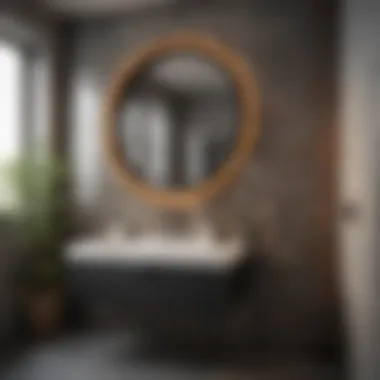

However, these tiles do come with their considerations. They typically require more upkeep, including sealing to prevent staining and ensuring that they withstand moisture over the years. Furthermore, the initial cost can be higher due to sourcing and installation factors. Despite these challenges, many homeowners find the beauty of natural stone worth the effort.
Glass Tiles
Glass tiles offer a stunning aesthetic that can brighten up any bathroom. Available in various colors and styles, they work well as accent pieces or even as full-wall treatments. These tiles reflect light, making small bathrooms appear more spacious.
Though beautiful, glass tiles need careful handling during installation, as they can easily chip. They are also more expensive and require specific adhesives for proper installation. As for cleaning, they repel dirt and grime, making routine maintenance a cinch.
"Glass tiles transform a simple bathroom into a luxury spa-like experience with their light-catching properties and vibrant colors."
Vinyl Tiles
For budget-conscious homeowners, vinyl tiles are often the go-to option. Vinyl is incredibly versatile, available in sheets, planks, or tiles, allowing for easy installation over existing floors. It’s water-resistant, making it a practical choice for bathrooms.
Moreover, the advancement in vinyl designs means many can convincingly mimic wood, stone, or other expensive materials. It’s soft underfoot, which adds comfort and can be easier on the joints. However, while vinyl is durable, it can wear out over time and may not be as stylish as its pricier counterparts.
In summary, understanding the types of bathroom tiles can significantly influence both the function and style of your renovation. Each variety has its distinct features, so homeowners should carefully evaluate their needs, aesthetics, and budget before making a decision.
Design Considerations
When it comes to renovating a bathroom, design considerations play a pivotal role in the overall outcome. Not only do these elements influence the aesthetic appeal of the space, but they also affect the functionality and comfort of your bathroom. Balancing beauty with practicality is key. A thoughtfully designed bathroom can transform a mundane routine into a relaxing retreat.
Color Schemes
Choosing a color scheme is one of the first steps in the tiling process. The colors you select can set the mood for your entire bathroom. Light shades can make a small area feel more spacious, while deeper hues can add a touch of sophistication. That said, it’s essential to consider how the chosen colors will interact with natural and artificial lighting.
For instance, pale blues and soft greens evoke tranquility and can simulate a spa-like atmosphere, perfect for unwinding after a long day. Alternatively, warm tones like terracotta can offer a cozy, inviting feel. Here are some options you might want to contemplate:
- Monochromatic: Sticking to various shades of one color can create a seamless look.
- Complementary: Using colors opposite each other on the color wheel can result in a vibrant contrast.
- Analogous: Choosing colors that are next to each other can create a harmonious look without being overabundant.
Greater consideration for color schemes can enhance tile selection, creating spaces that resonate with your personal style while maintaining a cohesive design.
Patterns and Textures
Patterns and textures add depth and intrigue to tile installations. They can break up visual monotony and draw the eye to specific areas, making them important elements to integrate. When working with patterns, remember the scale; large patterns in smaller bathrooms can overwhelm the space, while smaller patterns can become lost if the room is too large.
Texture is also crucial. Glossy tiles might reflect light beautifully but can be slippery when wet, whereas matte finishes can be safer underfoot, especially in a bathroom where water is abundant. Some innovative choices to consider include:
- Geometric Patterns: Triangles, hexagons, and chevrons can lend an element of modernity.
- Subway Tiles: A classic choice, often laid in various patterns like herringbone or stacked for added interest.
- 3D Textured Tiles: These can create a unique focal point, enhancing the overall visual aesthetic.
"A well-placed pattern or texture can become the star of your bathroom design journey, making even the simplest spaces feel exquisite."
Tile Formats and Sizes
Tile format and size are key considerations that can dramatically affect the dynamics of the bathroom. Available in a myriad of sizes, tiles can be employed in various configurations to achieve different effects. Large-format tiles help reduce the number of grout lines, offering a cleaner and more expansive look, which can be especially helpful in smaller bathrooms.
However, smaller tiles are often more versatile in terms of layout. They can be used in creative patterns or incorporated into intricate mosaics, giving the space a personalized touch.
In contemplating tile sizes, here are several things to consider:
- Small Tiles (like 1"x1"): Good for creating intricate designs and patterns but can require more grouting, making cleaning more time-consuming.
- Medium Tiles (like 12"x12"): A versatile size that offers a balance of aesthetics and practicality.
- Large Tiles (like 24"x24"): These can create a more spacious feel but might be heavier and require more precision during installation.
Choosing the right tile format allows for design creativity while ensuring that functional needs are met.
Evaluating Tile Durability
When embarking on a bathroom renovation, the durability of tiles cannot be overlooked. After all, a bathroom is a high-traffic area that deals with a unique set of challenges—moisture, spills, and the occasional unintentional mishap. Evaluating tile durability means assessing how well various tiles stand up against these everyday stresses. Choosing the right tile can lead to fewer repairs, maintain aesthetic appeal over time, and grant peace of mind knowing that your investment can endure the test of time.
A tile's durability is not just about its surface appearance but also about its performance under various operational conditions. Homeowners should focus on three specific durabilities: water resistance, scratch resistance, and stain resistance. With that in mind, let’s dive deeper into the first two aspects that every discerning homeowner should consider.
Water Resistance
Water resistance is paramount when selecting bathroom tiles, especially if you’re dealing with a shower or tub area. Not all tiles offer the same level of protection against water infiltration, so understanding this aspect is essential. Tiles that are resistant to water help to prevent mold and mildew growth, which can lead to costly repairs and health hazards.
Here’s what to keep in mind regarding water resistance:
- Impermeable Materials: Porcelain and ceramic tiles often come with a low water absorption rate, making them suitable for wet environments.
- Sealed Surfaces: Natural stone tiles, while beautiful, often require a sealant to enhance their water resistance. Without proper sealing, they can absorb water and become prone to damage.
- Grout Information: If using grout, opt for epoxy-based products known for their superior water resistance to further protect the tiled area.
Given those points, it’s clear that investing in water-resistant tiles not only adds product longevity but also creates an overall healthier space.
Scratch and Stain Resistance
In addition to handling moisture, bathroom tiles must withstand physical contact that can cause scratches or stains. Whether it’s a dropped bottle of shampoo or accidentally dragging a cleaning tool across the floor, the last thing any homeowner wants is to see unsightly marks on their newly tiled surfaces. Here’s how to assess scratch and stain resistance:
- Hardness Ratings: The Mohs hardness scale is essential when selecting tiles. Look for a tile with a rating of at least 5 or 6 for good durability. Porcelain tiles usually provide high resistance against scratches due to their dense composition, while softer options like vinyl can easily show signs of wear over time.
- Stain-Resistant Finishes: Some tiles come with a finish that helps repel stains. This can be particularly useful in a bathroom setting where products like lotions, soaps, or makeup can easily leave marks.
- Regular Maintenance: Though one may choose highly durable tiles, ongoing care is critical. Regular cleaning using appropriate solutions can help maintain both the appearance and longevity of the tiles.
An informed choice regarding tile durability means less worry in the future. A little research upfront can save time and costs in repairs down the line.
To sum it up, evaluating a tile's durability—specifically focusing on water resistance and scratch and stain resistance—plays a critical role in the overall success of a bathroom renovation. Make sure to prioritize these elements while selecting tiles that not only satisfy aesthetic aspirations but also fit the practical demands of everyday life.
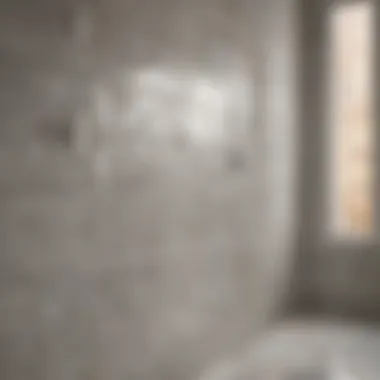

Eco-Friendly Tile Options
In today’s world, where environmental concerns seem to ripple through every decision we make, selecting eco-friendly tile options for your bathroom renovation is not just a trend; it's a responsibility. As we strive to enhance our living spaces, turning a keen eye to sustainability can mean making choices that not only uplift our homes but also protect our planet. Eco-friendly tiles can be a game changer. They can reduce your ecological footprint while adding a unique aesthetic charm to your bathroom. This section dives deep into the realm of recycled materials and sustainable sourcing practices to understand their significance.
Recycled Materials
Using tiles made from recycled materials is a great way to put waste to good use while still achieving a stunning look. These tiles can come from a variety of sources, including reclaimed ceramics, glass, and even rubber. Imagine stepping into a bathroom that features beautiful mosaic tiles crafted from old bottles or discarded tiles. The unique designs created from these materials can bring a one-of-a-kind flair to your space.
- Benefits of Recycled Tiles:
- Environmental Impact: Using recycled materials conserves resources and minimizes waste in landfills.
- Unique Aesthetic: Each piece is different, ensuring your design stands out amongst the ordinary.
- Durability: Many recycled tiles boast the same durability as new tiles, allowing for high-performance flooring or walls.
"Choosing recycled materials not only showcases your commitment to the environment but also tells a story of transformation and innovation."
However, it's essential to ensure that these tiles are sourced ethically and sustainably. Try to seek out local manufacturers, where possible. Not only does this support your community, but it also reduces the carbon footprint associated with transportation.
Sustainable Sourcing Practices
When we talk about sustainable sourcing, we’re looking at how tiles are produced and where the materials come from. Sustainable sourcing practices center around the idea of using materials that are mined or harvested in ways that are environmentally friendly and socially responsible.
The focus here is primarily on the lifecycle of the materials:
- Local Sourcing: Tiles made from locally sourced materials reduces the carbon footprint associated with long-distance transport.
- Certifications: Look for tiles that have certifications that attest to sustainable practices, such as LEED (Leadership in Energy and Environmental Design) or FSC (Forest Stewardship Council). These certifications provide assurance that the products meet rigorous environmental standards.
- Durability and Lifespan: Selecting tiles that are not only made sustainably but also durable will mean fewer replacements over time, which is a win for the environment and your pocketbook.
In essence, choosing sustainable sources for your tiling materials is a twofold benefit—it enhances the longevity of the product while safeguarding the environment. As a homeowner or a housewife, your choice can spark a change. So, whether it's opting for tiles made from recycled glass or looking for a tile supplier that practices fair-trade principles, each small choice contributes to a larger goal of sustainability.
Installation Process
The installation process of bathroom tiles is a critical stage in any renovation project. Proper execution can make the difference between a stunning, long-lasting finish and a troublesome, time-consuming mess. Understanding the nuances of installation is vital for achieving a look that not only appeals visually but also stands up to the rigors of bathroom use. A well-installed tile surface can resist moisture, prevent cracks, and save you from costly repairs down the line.
Preparing the Bathroom for Tiling
Before putting down any tile, the bathroom needs to be appropriately prepared. This preparation phase involves a few essential steps:
- Clearing the Space: Remove all existing fixtures and any debris from the installation area. Make sure cabinets, sinks, and lighting are out of the picture.
- Assessing the Surface: The subfloor must be inspected for any damage. Uneven or rotten subfloors will undermine the entire installation.
- Leveling the Surface: If there are inconsistencies in the surface, utilize a leveling compound. This ensures that the tiles lay flat, preventing future cracking.
- Moisture Barrier: Installing a moisture barrier helps deter water damage. Use a waterproof membrane around floor and wall areas, especially in high-humidity zones.
These initial steps may seem tedious, but they set the stage for a flawless installation. As the saying goes, "measure twice, cut once." Attention to detail here pays off later.
Adhesives and Grouting
Choosing the right adhesives and grout is crucial to tile longevity. It's not just about sticking tiles to the wall. The following considerations are essential:
- Type of Adhesive: Select a thin-set mortar or an adhesive specifically designed for tile. Epoxy-based adhesives tend to offer stronger bonds, particularly in wet areas.
- Flexible Grout: Opt for flexibility, especially for floor applications. Modified grouts that allow some movement can absorb impacts and prevent cracking.
- Waterproof Options: In bathrooms, waterproof grouts safeguard against mold and mildew. Look for options labeled as mold-resistant to enhance durability.
Correctly applying adhesives and grout also requires a steady hand. Make sure to spread the adhesive evenly and press each tile firmly into place. After everything is set, allowing proper curing time is vital before using the bathroom.
Professional Installation vs DIY
Deciding between hiring a professional or tackling a DIY project boils down to a few factors:
- Skill Level: If you're not feeling confident, a professional might be the way to go. They have the skills, tools, and experience to handle any complications.
- Budget Considerations: While DIY may save a pretty penny, remember to factor in the cost of tools and any potential mistakes that could require fixing. On the other hand, pros can quote you upfront, eliminating surprise costs.
- Time: Are you short on time? Professionals can usually complete the work more swiftly due to their expertise. DIY work can stretch out over several weekends, which may not be ideal in busy households.
Ultimately, weigh your options thoughtfully. Whether you choose to go the professional route or engage in some hands-on work, understanding the entire installation process will guide you to a resilient and aesthetically pleasing bathroom.
"The difference between a professional and an amateur is often just a little knowledge and a lot of practice."
Maintenance and Care
When it comes to bathroom renovation tiles, maintenance and care play a crucial role in preserving their beauty and functionality. Regular upkeep not only extends the lifespan of your tiles but also enhances the overall atmosphere of your bathroom. A well-maintained tile surface shines, reflects light, and can make your bathroom feel inviting. On the flip side, neglected tiles may lead to unsightly stains, dullness, and even damage, which ultimately can turn your serene oasis into a site of regret. Good practices in maintenance help you avoid potential hazards and keep your bathroom looking fresh.
Routine Cleaning Practices
Diligent cleaning is paramount for maintaining the pristine condition of your bathroom tiles. Here are some effective practices to ensure your tiles stay in tip-top shape:
- Daily Wipe Down: After each use, it's wise to give the tiles a gentle wipe with a soft cloth. This helps to remove moisture and prevents mildew buildup.
- Use Gentle Cleaners: Opt for pH-balanced or tile-specific cleaners to avoid any harsh chemicals that could strip away the tiles’ finish. A solution of vinegar and water can work wonders, especially on ceramic tiles.
- Regular Scrubbing: For grouted areas, a soft brush is your best friend. A quick scrub every week can keep grime at bay without damaging the tile surface.
- Avoid Abrasives: Steer clear of steel wool or harsh bristle brushes as these can scratch and dull your tiles’ surface.
- Immediate Spill Clean-Up: If you accidentally spill anything like soap or shampoo, promptly cleaning it up prevents staining and makes for hassle-free maintenance.
Long-Term Preservation Techniques
To secure the enduring beauty of your bathroom tiles, don’t overlook the importance of long-term preservation strategies. These techniques not only safeguard your investment but help maintain the integrity of your tiles for years to come:
- Sealing Grout Lines: This precaution doesn’t just protect; it can also make cleaning easier. A yearly application of a high-quality sealant on grout lines can prevent stains and water damage.
- Address Cracks promptly: If you spot any cracks or chips, address them right away. Filling minor imperfections can prevent water from seeping in and causing further issues.
- Temperature control: Ensure your bathroom is well-ventilated and that temperatures are stable. Extreme fluctuations can lead to shifts and cracks in tiles, especially in natural stone.
- Avoid Heavy Objects: Take care when handling heavy items in and around the bathroom. Dropping heavy things on your tiles can lead to breaks or chips that can compromise the aesthetics of the room.
- Regular Inspections: By routinely checking for signs of wear and tear, you can catch potential problems before they escalate. Keep an eye out for discoloration, cracking, or loose tiles, and remedy them before they spiral out of control.
"Taking a proactive approach to maintenance not only protects your investment but ensures that your bathroom remains a haven of relaxation and beauty."
Being consistent with both routine cleaning and long-term preservation techniques can keep your bathroom tiles looking breathtaking for years to come. It’s all about creating a harmonious balance between beauty and upkeep, allowing your renovations to serve you well into the future.
Trends in Bathroom Tile Design
As bathrooms increasingly become personal sanctuaries, the trends in tile design have evolved to reflect modern sensibilities and preferences. Tile choices can dramatically influence both the visual appeal and the ambiance of a bathroom. Staying in tune with the latest trends offers homeowners the chance to create spaces that are not only functional but also stylish and inviting. This section delves into three notable trends: bold colors and contrasts, minimalist aesthetics, and mixed materials. Each brings its own flair and can make a significant impact on the overall bathroom experience.
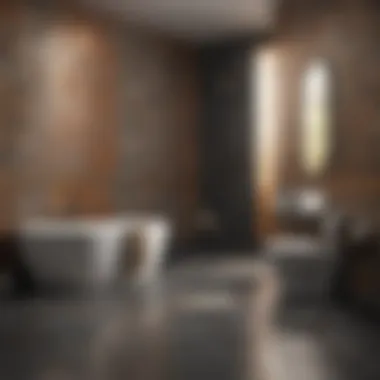

Bold Colors and Contrasts
Gone are the days when neutral tones ruled the bathroom landscape. Today, bold colors are taking center stage, often combined with contrasting shades to create vibrant focal points. Selecting deep navy blues, rich emerald greens, or fiery reds can bring life to the bathroom. When used effectively, these colors can evoke emotional responses and transform a mundane space into an exhilarating one.
Moreover, contrasting tiles, whether in color or texture, can add depth and dimension to the room. For instance, pairing bright patterned tiles with solid white or wood-effect finishes helps to balance the overall look while highlighting individual elements. This approach allows for creativity without overwhelming the senses.
- Some popular combinations include:
- Bright orange with soft grey
- Bold black with crisp white
- Turquoise tiles with natural stone accents
Consider incorporating bold colors into smaller areas, such as a shower nook or an accent wall, to avoid making the entire bathroom feel cramped or chaotic.
Minimalist Aesthetics
On the flip side, the minimalist trend emphasizes simplicity and functional beauty. This approach often involves using fewer colors and more streamlined designs to create a sense of peace and spaciousness. Minimalist bathrooms showcase clean lines, and large-format tiles can be ideal for achieving smooth surfaces with minimal grout lines, which enhances the sleek feel.
- Key features of minimalist aesthetics:
- Use of neutral palettes, such as whites, greys, and soft earth tones.
- Focus on unobtrusive fixtures and streamlined tile layouts.
- Limited decor to maintain an understated elegance.
This design philosophy can be particularly beneficial for smaller bathrooms, where visual clutter can be distracting. A minimalistic approach allows the space to breathe while ensuring that each element serves a purpose.
Mixed Materials
The trend of combining different tile materials has gained remarkable traction. Mixing tiles not only allows for unique designs but also provides diverse textures that can enhance sensory experiences in the bathroom. When executed well, this trend can elicit a sense of personal style that distinguishes your bathroom from the generic.
- Here are some popular material pairings to consider:
- Natural stone with ceramic tiles for a rustic charm.
- Glass tiles paired with porcelain to add an element of shine and reflectivity.
- Vinyl flooring complemented by ceramic wall tiles for practicality and comfort.
While experimenting with mixed materials, it's crucial to maintain a cohesive look by sticking to a consistent color palette or style. This way, you can enjoy a creative blend while avoiding a jarring or mismatched appearance.
"It's not just about choosing tiles; it's about creating a narrative that resonates with your style."
Through understanding these trends, homeowners can approach their bathroom renovations with a fresh perspective, ultimately enhancing both aesthetics and personal enjoyment.
Cost Considerations
When thinking about bathroom renovation, cost is often at the forefront of any homeowner’s mind. The choices made in this area can greatly influence not just the initial outlay but also long-term value and functionality. In the pursuit of aesthetic beauty, many may overlook the financial implications tied to tile selection and installation. It is crucial to strike a balance between desired design and budget constraints to set the project on a successful path.
Budgeting for Tile Purchases
Getting a pinch on how to budget for tile purchases can seem daunting at first. However, diving into specific elements can make this almost a walk in the park. Pricing of tiles varies widely, influenced by several factors, including type, size, and brand. Tiles made from natural stone might turn out to be costlier than ceramic or vinyl options. It's often a good idea to map out your priorities early on. Think about whether you want to splurge on statement pieces or aim for value options for the majority of the space.
Here are several thoughtful approaches for smart budgeting:
- Research Different Options: Before making any commitments, it's valuable to explore various suppliers to compare prices. You might find similar tiles at different price points.
- Measure Your Space: Know exactly how much tile you'll need. Not only does this help with calculating costs, but also prevents overspending on excess tile.
- Allow for Waste: Tiles can break during the installation, so it’s wise to purchase extra to cover any mishaps. A good rule of thumb is to get about 10% more than your calculated requirement.
- Consider All Costs: Don't just think about the tile price. Factor in shipping costs, taxes, and any contractor fees that may apply.
By focusing on these pointers, budgeting becomes less intimidating, and you can allocate funds more effectively to align with your vision.
Estimating Installation Costs
Once the budget for tile purchases is in place, the next step is to turn the attention toward installation costs. This aspect can sometimes take homeowners by surprise, as it might involve various expenses, such as labor, materials, and any special equipment needed for the job.
Here are a few elements to consider when estimating installation costs:
- Labor: Depending on your location, labor costs can vary significantly. Getting quotes from multiple contractors can help ensure that you’re not overpaying for installation.
- Prep Work: If it involves removing old tiles or prepping the surface, factor these additional costs into the overall estimate.
- Installation Method: The style of installation chosen will also influence costs. For instance, intricate mosaics or specialty patterns often require more labor than standard grid layouts.
Quote from a Professional: "The clearer your vision, the easier it becomes to estimate costs upfront. A well-thought-out plan can save headaches down the line."
- Additional Materials: Beyond tiles, you might need adhesive, grout, or other materials that stack up in price. Always ensure these are included in your estimates.
By spending time on both budgeting for tiles and calculating installation expenses, you can navigate the financial side of bathroom renovation more effectively. Taking these considerations into account can ensure that the project not only enhances your space but also aligns with your financial expectations.
Closure
Wrapping up our exploration of bathroom renovation tiles, it becomes evident that selecting the right tiles, understanding their installation, and maintaining their allure is not just an art but a pivotal part of enhancing your home. Tiles act as the canvas on which the rest of your bathroom's charm and utility rest.
When choosing tiles, the myriad of options can turn overwhelming. From ceramic to glass, each material has its own quirks and perks. Thus, having a clear understanding of your needs, preferences, and the room's character becomes crucial. It's one thing to fancy the look of a vintage tile but another to consider its performance in a moist environment. Choosing wisely can save you time, effort, and money in the long run.
Installation is equally important. Whether you opt for a DIY approach or hire a professional, the quality of installation directly affects durability and aesthetics. Poorly placed tiles can lead to leaks and unattractive surfaces that no one wants to look at. Being attentive to this process ensures that your hard work and investment pay off.
Maintenance has to be top of mind. Regular upkeep not only enhances the look but prolongs the lifespan of tiles. A little effort here goes a long way; neglect can lead to issues that might require costly repairs down the line.
"The right tiles can transform any bathroom into a sanctuary, marrying beauty with functionality."
Taking care to evaluate your choices thoroughly leads to an environment that is not just pleasing to the eye, but also practical and sustainable. When you consider factors like water resistance and eco-friendly options, you're not just making a design statement; you're setting a foundation for a serene bathroom that endures through the years.
Final Thoughts on Tile Selection and Installation
Here are some key points to reflect upon:
- Know Your Space: Understand the bathroom area you’re working with. Size, light, and existing colors should influence your selection.
- Mix and Match: Don’t shy away from combining different tile types or patterns. This can add depth and character to your space.
- Prioritize Functionality: Consider how each tile type will hold up in a bathroom setting, especially regarding moisture and cleaning requirements.
- Seek Professional Advice: When in doubt, consult an experienced installer. Their insights can prove invaluable, especially in navigating tricky layouts.
In the realm of bathroom renovation, tiles serve as more than mere flooring or wall coverings; they are elements that contribute significantly to the overall comfort, style, and value of your home. Every step taken in the selection and installation process ultimately can lead you to a bathroom space that is as functional as it is beautiful.











